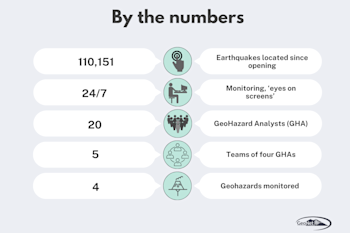
NGMC Turns Five
Powered by GeoNet and GNS Science experts – today we’re celebrating the fifth birthday of our National Geohazards Monitoring Centre / Te Puna Mōrearea i te Rū (NGMC), a purpose-built facility providing around-the-clock monitoring of tsunami, volcano, earthquake and landslide hazards to help keep New Zealanders safe.
On Wednesday 12 December 2018 the NGMC went live, built upon decades of work that GNS Science and the GeoNet programme have done with Toka Tu Ake EQC and Toitū Te Whenua Land Information New Zealand.
Working in three shifts over a 24-hour period, Geohazard Analysts ensure that all events are captured and analysed as soon as they happen. When a significant event occurs, the NGMC team have continuous situational awareness, and can run tools and begin interpretation as quickly as possible. The NGMC can then activate a team of on-call duty officers from across GNS Science. Prior to the NGMC, on-call duty officers would receive automated messages – quickly firing up their laptop and analysing these events themselves. They’d often be working at home with remote monitoring tools and could have been fast asleep.
Now, when an event occurs, we can hit the ground running to provide information fast to decision makers such as the National Emergency Management Agency’s Monitoring, Alerting and Reporting (MAR) Centre, so that they can make informed decisions and determine the appropriate advice and warnings to issue to the public.
Since its launch, the centre has located more than 110,151 earthquakes and has played a vital role in GNS Science’s contribution to national event responses including the Whakaari/White Island eruption in December 2019, the rare ‘three tsunami day’ on 5 March 2021 and 2022 unrest at Taupō volcano and recent response to Cyclone Gabrielle.
Improvements to the centre are constantly being driven by the centres’ culture of continuous improvement, leading science at GNS Science and with collaborators around Aotearoa and internationally.
The centre is funded through the Ministry of Business Innovation and Employment’s Strategic Science Investment Fund and is also supported by the National Emergency Management Agency.
Did you know?
Our seismic instruments record more than just earthquakes. They also detect all sorts of activities around New Zealand, such as Rocket Lab launches, lightning strikes, quarry blasts, army detonations and even music gigs.
Listen: Last week’s RNZ Our Changing World episode on geohazard monitoring and event response. GNS Geohazard Analyst Kim Presow and Duty Seismologist Dr Jono Hanson share their experiences working in our geohazard monitoring centre and responding to large geohazard events like tsunami threats.
Earthquakes can occur anywhere in New Zealand at any time. In the event of a large earthquake: Drop, Cover and Hold.
Remember Long or Strong, Get Gone : If you are near the coast and feel a strong earthquake that makes it hard to stand up OR a weak rolling earthquake that lasts a minute or more move immediately to the nearest high ground or as far inland as you can, out of tsunami evacuation zones.
Know what to do?
The National Emergency Management Agency (NEMA) has a great website with information on what to do before, during and after an earthquake.
Prepare your home. Protect your whānau.
There’s a lot we can do to make our homes safer and stronger for natural hazards. Toka Tū Ake EQC’s website has key steps to get you started.
Media Contact: 021 574 541 or media@gns.cri.nz



